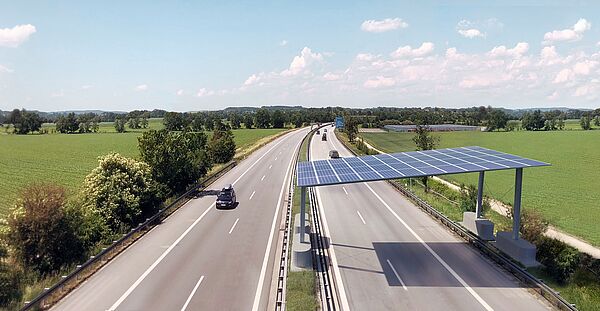What is integrated photovoltaics?
Integrated photovoltaics (BIPV) refers to the direct integration of solar modules into built infrastructure. Unlike conventional solar installations, BIPV systems serve dual purposes: generating energy and fulfilling architectural functions such as thermal insulation, soundproofing, or weather protection.
Advantages of Integrated Photovoltaics:
- Dual Functionality: Power generation combined with structural building elements.
- Aesthetic Adaptation: Seamless integration with architectural design.
- Cost Reduction: Lower overall costs through multifunctional use.
- Promotion of Sustainable Construction: Supporting eco-friendly building practices.
- Utilization of Already Sealed Surfaces: Making use of existing spaces effectively.
Applications of integrated photovoltaics
Integrated photovoltaics (BIPV) can be utilized in various areas:
Facades
Solar facades combine design and functionality by being both aesthetically pleasing and energy-efficient.
Roofs
BIPV roof systems replace traditional roofing materials, serving the dual purpose of protection and energy generation.
Windows and Glass Surfaces
Transparent photovoltaic modules provide sun protection and energy generation, making them ideal for modern buildings with glass architecture.
PV Canopies for Parking Lots
Photovoltaic parking lot canopies enable efficient use of existing spaces by transforming parking areas into sustainable energy sources without additional land use.
Agro-Photovoltaics: Energy and Agriculture Combined
Agro-photovoltaics refers to the use of solar installations on agricultural land, where energy generation and farming occur on the same plot. This technology maximizes land use, offering both economic and ecological benefits.
Noise Barriers
Noise barriers along transportation routes serve the important purpose of shielding nearby residents from traffic noise. These sealed surfaces can also be repurposed to generate clean, local eco-energy through the installation of PV systems. Photovoltaic panels are either directly installed on the noise barriers or integrated as part of their design. The generated energy can be used to power road infrastructure such as lighting or traffic management systems.
Future of integrated photovoltaics
The growing demand for energy-efficient buildings and multifunctional use of existing surfaces is driving the development of integrated photovoltaics. Key innovation areas include:
- Increasing the efficiency of solar modules.
- Integration of storage systems.
- Comprehensive planning for a fully functional overall concept.
Integrated photovoltaics: services provided by AIT
The AIT Austrian Institute of Technology offers comprehensive services in the field of integrated photovoltaics, ranging from system and component design to feasibility studies. AIT’s diverse services include:
System and Component Design
Precise planning of photovoltaic systems is essential for their efficiency and durability. AIT provides support through:
- Combined simulation of components and overall systems: Using integrated planning methods, both individual components and entire systems are optimized.
- Customization for specific requirements: Tailored solutions are developed to meet the diverse needs of planners, investors, and building operators.
Feasibility Studies
Before implementing a photovoltaic project, sound feasibility studies are critical. AIT offers:
- Technical and economic analyses: Evaluation of project feasibility, considering current technologies and market conditions.
- Risk assessments: Identification of potential challenges and development of strategies to address them.
Energy Yield Analysis
A key factor in the profitability of photovoltaic systems is the expected energy yield. AIT conducts detailed analyses to:
- Develop yield forecasts: Accurate predictions based on site data and system configurations.
- Identify optimization opportunities: Simulations are used to detect weaknesses and propose improvement measures.
PV Module Testing for Specific Applications
The quality of the modules used significantly impacts the performance of a system. AIT provides:
- Independent performance measurements: Objective evaluation of module performance under real-world conditions.
- Quality testing and accelerated aging tests: Ensuring the longevity and reliability of the modules.
Advantages of AIT services
By utilizing AIT's services, customers benefit from:
- Optimized utilization of solar energy potential: Maximizing energy yield through tailored solutions.
- Proven implementation concepts: Established methods ensure smooth execution.
- Guaranteed quality for high performance and long lifespan: Rigorous testing and analyses ensure system reliability.
The Austrian Institute of Technology offers a comprehensive range of services in the field of integrated photovoltaics. Through in-depth analyses, precise planning, and stringent quality controls, AIT ensures that photovoltaic projects are implemented efficiently, sustainably, and with economic success.
Our Services
- System and Component Design
Combined simulation of components and overall systems for integrated planning. - Feasibility Studies
- Energy Yield Analysis
- PV Module Testing for Specific Applications
Your Benefits
- Optimized Utilization of Solar Energy Potential
- Proven Concepts for Implementation
- Guaranteed Quality for High Performance and Long Lifespan of Integrated PV Systems




